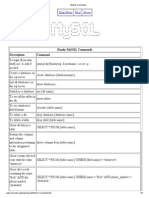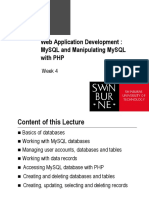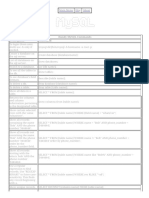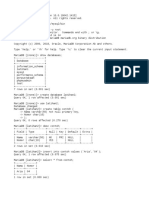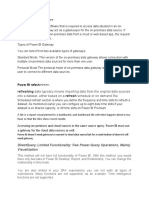Mysql Commands
Uploaded by
suntmMysql Commands
Uploaded by
suntmShort List of MySQL Commands
http://www.bios.niu.edu/johns/bioinform/mysql...
Short List of MySQL Commands
Conventions used here:
MySQL key words are shown in CAPS
User-specified names are in small letters
Optional items are enclosed in square brackets [ ]
Items in parentheses must appear in the command, along with the parentheses
Items that can be repeated as often as desired are indicated by an ellipsis ...
Quoting in MySQL statments
Don't quote database, table, or column names
Don't quote column types or modifiers
Don't quote numerical values
Quote (single or double) non-numeric values
Quote file names and passwords
User names are NOT quoted in GRANT or REVOKE statements, but they are quoted in other
statements.
General Commands
USE database_name
Change to this database. You need to change to some database when you first connect to MySQL.
SHOW DATABASES
Lists all MySQL databases on the system.
SHOW TABLES [FROM database_name]
Lists all tables from the current database or from the database given in the command.
DESCRIBE table_name
SHOW FIELDS FROM table_name
SHOW COLUMNS FROM table_name
These commands all give a list of all columns (fields) from the given table, along with column type
and other info.
SHOW INDEX FROM table_name
Lists all indexes from this tables.
SET PASSWORD=PASSWORD('new_password')
Allows the user to set his/her own password.
Table Commands
CREATE TABLE table_name (create_clause1, create_clause2, ...)
Creates a table with columns as indicated in the create clauses.
1 of 4
Short List of MySQL Commands
http://www.bios.niu.edu/johns/bioinform/mysql...
create_clause
column name followed by column type, followed optionally by modifiers. For example, "gene_id INT
AUTO_INCREMENT PRIMARY KEY" (without the quotes) creates a column of type integer with the
modifiers described below.
create_clause modifiers
AUTO_INCREMENT : each data record is assigned the next sequential number when it is
given a NULL value.
PRIMARY KEY : Items in this column have unique names, and the table is indexed
automatically based on this column. One column must be the PRIMARY KEY, and only one
column may be the PRIMARY KEY. This column should also be NOT NULL.
NOT NULL : No NULL values are allowed in this column: a NULL generates an error message
as the data is inserted into the table.
DEFAULT value : If a NULL value is used in the data for this column, the default value is
entered instead.
DROP TABLE table_name
Removes the table from the database. Permanently! So be careful with this command!
ALTER TABLE table_name ADD (create_clause1, create_clause2, ...)
Adds the listed columns to the table.
ALTER TABLE table_name DROP column_name
Drops the listed columns from the table.
ALTER TABLE table_name MODIFY create_clause
Changes the type or modifiers to a column. Using MODIFY means that the column keeps the same
name even though its type is altered. MySQL attempts to convert the data to match the new type:
this can cause problems.
ALTER TABLE table_name CHANGE column_name create_clause
Changes the name and type or modifiers of a column. Using CHANGE (instead of MODIFY) implies
that the column is getting a new name.
ALTER TABLE table_name ADD INDEX [index_name] (column_name1, column_name2, ...)
CREATE INDEX index_name ON table_name (column_name1, column_name2, ...)
Adds an index to this table, based on the listed columns. Note that the order of the columns is
important, because additional indexes are created from all subsets of the listed columns reading from
left to write. The index name is optional if you use ALTER TABLE, but it is necesary if you use
CREATE INDEX. Rarely is the name of an index useful (in my experience).
Data Commands
INSERT [INTO] table_name VALUES (value1, value2, ...)
Insert a complete row of data, giving a value (or NULL) for every column in the proper order.
INSERT [INTO] table_name (column_name1, column_name2, ...) VALUES (value1, value2, ...)
INSERT [INTO] table_name SET column_name1=value1, column_name2=value2, ...
Insert data into the listed columns only. Alternate forms, with the SET form showing column
assignments more explicitly.
2 of 4
Short List of MySQL Commands
http://www.bios.niu.edu/johns/bioinform/mysql...
INSERT [INTO] table_name (column_name1, column_name2, ...) SELECT
list_of_fields_from_another_table FROM other_table_name WHERE where_clause
Inserts the data resulting from a SELECT statement into the listed columns. Be sure the number of
items taken from the old table match the number of columns they are put into!
DELETE FROM table_name WHERE where_clause
Delete rows that meet the conditions of the where_clause. If the WHERE statement is omitted, the
table is emptied, although its structure remains intact.
UPDATE table_name SET column_name1=value1, column_name2=value2, ... [WHERE
where_clause]
Alters the data within a column based on the conditions in the where_clause.
LOAD DATA LOCAL INFILE 'path to external file' INTO TABLE table_name
Loads data from the listed file into the table. The default assumption is that fields in the file are
separated by tabs, and each data record is separated from the others by a newline. It also assumes
that nothing is quoted: quote marks are considered to be part of the data. Also, it assumes that the
number of data fields matches the number of table columns. Columns that are AUTO_INCREMENT
should have NULL as their value in the file.
LOAD DATA LOCAL INFILE 'path to external file' [FIELDS TERMINATED BY
'termination_character'] [FIELDS ENCLOSED BY 'quoting character'] [LINES TERMINATED BY
'line termination character'] FROM table_name
Loads data from the listed file into the table, using the field termination character listed (default is tab
\t), and/or the listed quoting character (default is nothing), and/or the listed line termination
chacracter (default is a newline \n).
SELECT column_name1, column_name2, ... INTO OUTFILE 'path to external file' [FIELDS
TERMINATED BY 'termination_character'] [FIELDS ENCLOSED BY 'quoting character'] [LINES
TERMINATED BY 'line termination character'] FROM table_name [WHERE where_clause]
Allows you to move data from a table into an external file. The field and line termination clauses are
the same as for LOAD above. Several tricky features:
1. Note the positions of the table_name and where_clause, after the external file is given.
2. You must use a complete path, not just a file name. Otherwise MySQL attempts to write to the
directory where the database is stored, where you don't have permission to write.
3. The user who is writing the file is 'mysql', not you! This means that user 'mysql' needs
permission to write to the directory you specify. The best way to do that is to creat a new
directory under your home directory, then change the directory's permission to 777, then write
to it. For example: mkdir mysql_output, chmod 777 mysql_output.
Privilege Commands
Most of the commands below require MySQL root access
GRANT USAGE ON *.* TO user_name@localhost [IDENTIFIED BY 'password']
Creates a new user on MySQL, with no rights to do anything. The IDENTIFED BY clause creates or
changes the MySQL password, which is not necessarily the same as the user's system password.
The @localhost after the user name allows usage on the local system, which is usually what we do;
leaving this off allows the user to access the database from another system. User name NOT in
3 of 4
Short List of MySQL Commands
http://www.bios.niu.edu/johns/bioinform/mysql...
quotes.
GRANT SELECT ON *.* TO user_name@localhost
In general, unless data is supposed to be kept private, all users should be able to view it. A
debatable point, and most databases will only grant SELECT privileges on particular databases.
There is no way to grant privileges on all databses EXCEPT specifically enumerated ones.
GRANT ALL ON database_name.* TO user_name@localhost
Grants permissions on all tables for a specific database (database_name.*) to a user. Permissions
are for: ALTER, CREATE, DELETE, DROP, INDEX, INSERT, SELECT, UPDATE.
FLUSH PRIVILEGES
Needed to get updated privileges to work immediately. You need RELOAD privileges to get this to
work.
SET PASSWORD=PASSWORD('new_password')
Allows the user to set his/her own password.
REVOKE ALL ON [database_name.]* FROM user_name@localhost
Revokes all permissions for the user, but leaves the user in the MySQL database. This can be done
for all databases using "ON *", or for all tables within a specific databse, using "ON
database_name.*".
DELETE FROM mysql.user WHERE user='user_name@localhost'
Removes the user from the database, which revokes all privileges. Note that the user name is in
quotes here.
UPDATE mysql.user SET password=PASSWORD('my_password') WHERE user='user_name'
Sets the user's password. The PASSWORD function encrypts it; otherwise it will be in plain text.
SELECT user, host, password, select_priv, insert_priv, shutdown_priv, grant_priv FROM
mysql.user
A good view of all users and their approximate privileges. If there is a password, it will by an
encrytped string; if not, this field is blank. Select is a very general privlege; insert allows table
manipulation within a database; shutdown allows major system changes, and should only be usable
by root; the ability to grant permissions is separate from the others.
SELECT user, host, db, select_priv, insert_priv, grant_priv FROM mysql.db
View permissions for individual databases.
4 of 4
You might also like
- Handy Mysql Commands Description CommandNo ratings yetHandy Mysql Commands Description Command3 pages
- PHP and Mysql: John Ryan B. Lorca Instructor INo ratings yetPHP and Mysql: John Ryan B. Lorca Instructor I57 pages
- CourseLecture1,2 Using Mysql To Manage DatabasesNo ratings yetCourseLecture1,2 Using Mysql To Manage Databases28 pages
- MySQL Tutorial - MySQL by Examples For Beginners PDFNo ratings yetMySQL Tutorial - MySQL by Examples For Beginners PDF36 pages
- Presentation Mysql Training 1499248676 292960No ratings yetPresentation Mysql Training 1499248676 29296077 pages
- Server Side Programming: by Dr. Babaousmail Hassen Lecturer at Binjiang College of NUISTNo ratings yetServer Side Programming: by Dr. Babaousmail Hassen Lecturer at Binjiang College of NUIST12 pages
- Handy Mysql Commands Description Command: Main Menu Blog AboutNo ratings yetHandy Mysql Commands Description Command: Main Menu Blog About2 pages
- PHP & Mysql Lab 2: Amazon Barnes & NobleNo ratings yetPHP & Mysql Lab 2: Amazon Barnes & Noble7 pages
- Handy Mysql Commands Description Command: Main Menu Blog AboutNo ratings yetHandy Mysql Commands Description Command: Main Menu Blog About3 pages
- Online Visualization of Bibliography Using Visualization TechniquesNo ratings yetOnline Visualization of Bibliography Using Visualization Techniques43 pages
- Ip San Fundamentals: An Introduction To Ip Sans and Iscsi: Updated April 2007No ratings yetIp San Fundamentals: An Introduction To Ip Sans and Iscsi: Updated April 200719 pages
- Ip San Fundamentals: An Introduction To Ip Sans and Iscsi: Updated April 2007No ratings yetIp San Fundamentals: An Introduction To Ip Sans and Iscsi: Updated April 200719 pages
- Setting Up IPMI and Serial Over LAN On Red Hat Enterprise Linux 3 and 4No ratings yetSetting Up IPMI and Serial Over LAN On Red Hat Enterprise Linux 3 and 46 pages
- Backup and Recovery From Xopero Software: Product OverviewNo ratings yetBackup and Recovery From Xopero Software: Product Overview4 pages
- Oracle 5 Database Administration BookletNo ratings yetOracle 5 Database Administration Booklet172 pages
- L-2 - Components & Functions of DBMS PDFNo ratings yetL-2 - Components & Functions of DBMS PDF18 pages
- Count The Number of Occurrences in A Sorted Array - GeeksforGeeksNo ratings yetCount The Number of Occurrences in A Sorted Array - GeeksforGeeks15 pages
- CSC3064 Database Engineering: Entity-Relationship (E-R) ModelingNo ratings yetCSC3064 Database Engineering: Entity-Relationship (E-R) Modeling7 pages
- MySQL Tutorial - MySQL by Examples For Beginners PDFMySQL Tutorial - MySQL by Examples For Beginners PDF
- Server Side Programming: by Dr. Babaousmail Hassen Lecturer at Binjiang College of NUISTServer Side Programming: by Dr. Babaousmail Hassen Lecturer at Binjiang College of NUIST
- Handy Mysql Commands Description Command: Main Menu Blog AboutHandy Mysql Commands Description Command: Main Menu Blog About
- Handy Mysql Commands Description Command: Main Menu Blog AboutHandy Mysql Commands Description Command: Main Menu Blog About
- Online Visualization of Bibliography Using Visualization TechniquesOnline Visualization of Bibliography Using Visualization Techniques
- Ip San Fundamentals: An Introduction To Ip Sans and Iscsi: Updated April 2007Ip San Fundamentals: An Introduction To Ip Sans and Iscsi: Updated April 2007
- Ip San Fundamentals: An Introduction To Ip Sans and Iscsi: Updated April 2007Ip San Fundamentals: An Introduction To Ip Sans and Iscsi: Updated April 2007
- Setting Up IPMI and Serial Over LAN On Red Hat Enterprise Linux 3 and 4Setting Up IPMI and Serial Over LAN On Red Hat Enterprise Linux 3 and 4
- Backup and Recovery From Xopero Software: Product OverviewBackup and Recovery From Xopero Software: Product Overview
- Count The Number of Occurrences in A Sorted Array - GeeksforGeeksCount The Number of Occurrences in A Sorted Array - GeeksforGeeks
- CSC3064 Database Engineering: Entity-Relationship (E-R) ModelingCSC3064 Database Engineering: Entity-Relationship (E-R) Modeling

